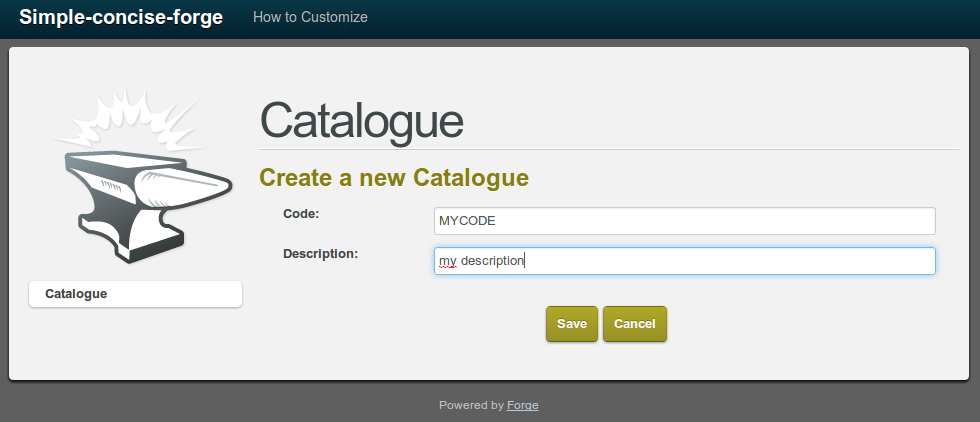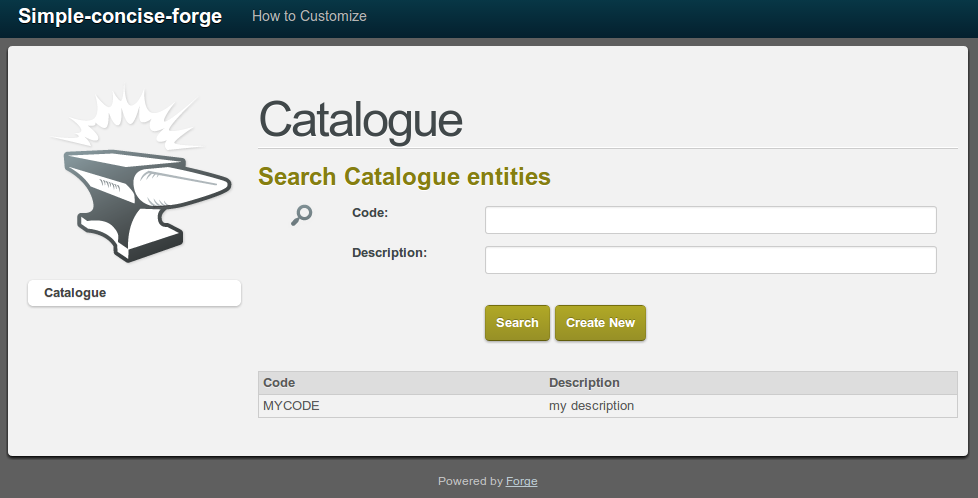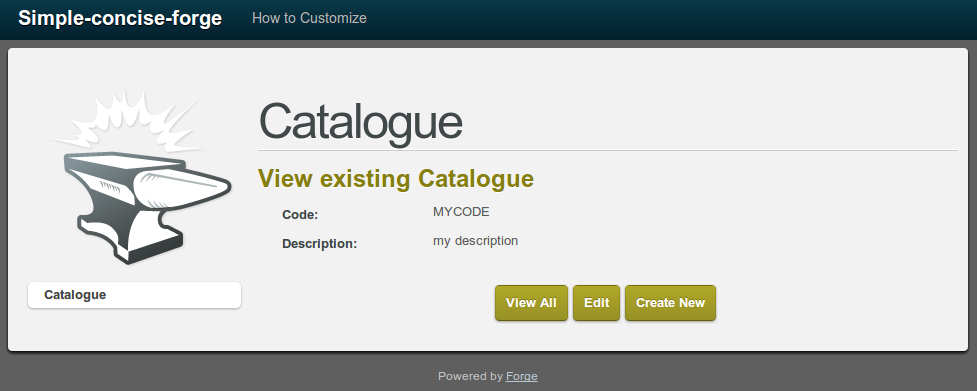01.02.01 Basic UI - Forge 01 - Sample Use Case - Basic UI
Sample Use Case - Basic UI
Forge is a project by JBoss that aims to accelerate application development by means of a Command Line Interface and IDE Plugins, for this sample I’ll stay with the CLI.
forge
Using Forge at /home/rmm/bin/forge-distribution-2.5.0.Final
Warning: JAVA_HOME environment variable is not set.
_____
| ___|__ _ __ __ _ ___
| |_ / _ \| `__/ _` |/ _ \ \\
| _| (_) | | | (_| | __/ //
|_| \___/|_| \__, |\___|
|___/
JBoss Forge, version [ 2.5.0.Final ] - JBoss, by Red Hat, Inc. [ http://forge.jboss.org ]
[simple-concise-code]$ project-new --named simple-concise-forge \
--topLevelPackage mx.rmm.simpleconcise.forge \
--version 1.0-SNAPSHOT \
--type war \
--buildSystem Maven
Now we have an empty project with this layout
├── simple-concise-forge
│ ├── pom.xml
│ └── src
│ ├── main
│ │ ├── java
│ │ ├── resources
│ │ └── webapp
│ └── test
│ ├── java
│ └── resources
Configuring our persistence engine and validation tools
[simple-concise-forge]$ jpa-setup --jpaVersion 2.0 --container JBOSS_AS7 \
--provider Hibernate
***SUCCESS*** Persistence (JPA) is installed.
[simple-concise-forge]$ constraint-setup
***SUCCESS*** Bean Validation is installed.
simple-concise-forge/
├── pom.xml
└── src
├── main
│ ├── java
│ ├── resources
│ │ └── META-INF
│ │ ├── persistence.xml
│ │ └── validation.xml
│ └── webapp
└── test
├── java
└── resources
9 directories, 3 files
Sample 01 - Single entity
Adding an entity is quite simple
[simple-concise-forge]$ jpa-new-entity --named Catalogue
***SUCCESS*** Entity mx.rmm.simpleconcise.forge.model.Catalogue created
[Catalogue.java]$ jpa-new-field --named code \
--type String --length 10
***SUCCESS*** Field code created
[Catalogue.java]$ jpa-new-field --named description \
--type String --length 100
***SUCCESS*** Field description created
Now our structure looks like this
simple-concise-forge/
├── pom.xml
└── src
├── main
│ ├── java
│ │ └── mx
│ │ └── rmm
│ │ └── simpleconcise
│ │ └── forge
│ │ └── model
│ │ └── Catalogue.java
│ ├── resources
│ │ └── META-INF
│ │ ├── persistence.xml
│ │ └── validation.xml
│ └── webapp
└── test
├── java
└── resources
14 directories, 4 files
Forge is able to build all scaffolding UI using JSF and facelets from just this previous actions but first some extra setup steps are needed.
[simple-concise-forge]$ scaffold-setup --provider Faces \
--facesVersion 2.1 --ejbVersion 3.1 --servletVersion 3.0 --cdiVersion 1.0
***SUCCESS*** CDI has been installed.
***SUCCESS*** EJB has been installed.
***SUCCESS*** Servlet API has been installed.
***SUCCESS*** JavaServer Faces has been installed.
***SUCCESS*** Scaffold was setup successfully.
Structure
simple-concise-forge/
├── pom.xml
└── src
├── main
│ ├── java
│ │ └── mx
│ │ └── rmm
│ │ └── simpleconcise
│ │ └── forge
│ │ └── model
│ │ └── Catalogue.java
│ ├── resources
│ │ └── META-INF
│ │ ├── persistence.xml
│ │ └── validation.xml
│ └── webapp
│ ├── error.xhtml
│ ├── index.html
│ ├── index.xhtml
│ ├── resources
│ │ ├── add.png
│ │ ├── bootstrap.css
│ │ ├── false.png
│ │ ├── favicon.ico
│ │ ├── forge-logo.png
│ │ ├── forge-style.css
│ │ ├── jboss-community.png
│ │ ├── remove.png
│ │ ├── scaffold
│ │ │ ├── pageTemplate.xhtml
│ │ │ └── paginator.xhtml
│ │ ├── search.png
│ │ └── true.png
│ └── WEB-INF
│ ├── beans.xml
│ ├── faces-config.xml
│ └── web.xml
└── test
├── java
└── resources
17 directories, 22 files
Those are just templates, we need to generate scaffolding for specific entities.
[simple-concise-forge]$ scaffold-generate --targets \
mx.rmm.simpleconcise.forge.model.Catalogue
***SUCCESS*** Scaffold was generated successfully.
Structure
simple-concise-forge/
├── pom.xml
└── src
├── main
│ ├── java
│ │ └── mx
│ │ └── rmm
│ │ └── simpleconcise
│ │ └── forge
│ │ ├── model
│ │ │ └── Catalogue.java
│ │ └── view
│ │ ├── CatalogueBean.java
│ │ └── ViewUtils.java
│ ├── resources
│ │ └── META-INF
│ │ ├── persistence.xml
│ │ └── validation.xml
│ └── webapp
│ ├── catalogue
│ │ ├── create.xhtml
│ │ ├── search.xhtml
│ │ └── view.xhtml
Let’s see what kind of UI forge has generated.

Simple enough there is a menu on the left with our scaffolded entity.

Now we see a couple of search fields and buttons to add new entities. Adding an entity is quite simple so let’s do it.

Fill all the fields and press save

And now it appears on the list below and we are able to drill into it’s detailed page

Easy and to the point, now let’s count lines.
simple-concise-forge$ for EXTN in \
`find -type f | sed -r 's|.*(\.[a-z]*)|\1|g'|sort -u` ;\
do echo $EXTN ; \
find -iname "*$EXTN" | xargs wc -l | grep total;\
done
.css
5677 total
.java
514 total
.xhtml
327 total
.xml
173 total
Just about 1 Kloc without taking into consideration language complexities, I’m just interested on a ballpark line count to correlate vs current industry metrics. With this in mind i’ve just become a lot more “productive” but there are problems with this implementation that will become very troublesome.
You can find the source files here.
Let’s continue our example by adding our state machine to this.